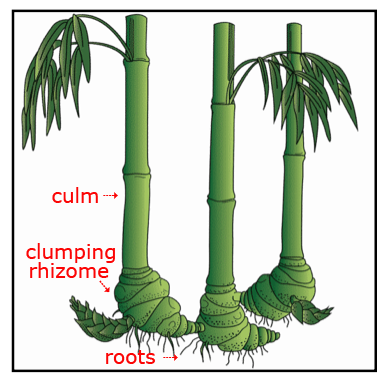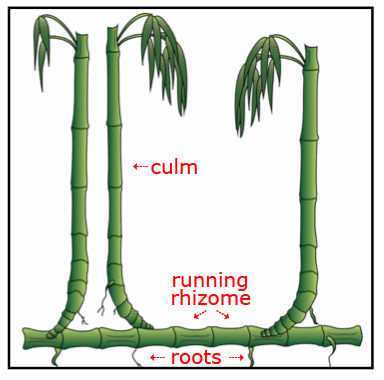
Bamboo
Bamboo can be visually appealing, an effective deer-resistant privacy fence, and provide environmental benefits BUT it can have downsides depending on the type of bamboo you wish to plant and what you want to achieve in planting it. Certain varieties are invasive and can outcompete native plants, test neighbor relationships, and be costly, labor intensive, and time consuming to remove.
If you are considering planting it, already have it, or it is growing near your property, it is important to know its growth habit and how to maintain and contain it if necessary. The invasiveness of bamboo, its growth rate, and appropriate dimensions for barriers depends on factors such as species, climate, and soil conditions - the following will help serve as a guide.
● Clumping bamboo is non-invasive and primarily grows upright stalks (culms) in the area where it is planted. It grows outward in a circular pattern, widening as the shoots grow taller. Clumping varieties will form dense screens but at a slower pace than running bamboo. Choose a clumping variety whenever spreading is undesirable and root barrier installation is too expensive or difficult due to tree roots, steep slopes, or other impediments.
● Running bamboo, unlike clumping bamboo, does not stay put in the area where it is planted. Instead, it vigorously sends out underground runners (known as rhizomes, which are technically horizontal culms) that produce roots below and shoots above, both near and far . . . sometimes as far as into your neighbor’s property. It makes an excellent privacy screen and can prevent soil erosion on slopes but do not plant running bamboo unless you intend to monitor it closely and properly contain it. Running bamboo generally spreads 3 to 5 feet per year, but some varieties can spread up to 15 feet per year!


Controlling growth -
Given the relatively slow growth of clumping bamboo, its shallow roots, and discrete clumps, containment is more manageable than running bamboo. Choose the proper location and concerns regarding control will not be an issue. If necessary, the plant can be shaped by removing new shoots at soil level in the event they begin to grow too close to nearby structures.
However, if you are planting a vigorous growing bamboo, such as the running type, a barrier should be installed to protect neighboring properties as well as your own. The barrier should surround the bamboo completely. Barriers can be concrete, sheet metal, or plastic, however, concrete can crack and sheet metal can rust and develop holes so a plastic bamboo barrier would be a safer choice for the long term. Running bamboo roots can go down a couple of feet in depth although rhizomes, the part that spreads horizontally, usually stay to a depth lo 6-12”. A plastic barrier of at least 40mil in thickness and at least 24-30” in width is suggested to safely clear the depth of the roots. Once the barrier is installed, check the top of the barrier at least once a year. Cut back any bamboo growing over the top of the barrier to prevent it from escaping.
Alternative methods include:
(1) Digging a trench about 10-12" deep and 12" wide around the plants. The rhizomes that spread horizontally stay close to the surface and you will be able to see them poking through the sides of the trench. When you see them, cut them with a pair of hand pruners, loppers, or a sharp shovel. (or)
(2) Planting the bamboo in a raised planting bed that is surrounded by wall or cement or in a container.
Bamboo can be pruned to control its growth and for shaping. It can be pruned anytime of the year except the growing season when new shoots appear so as to not damage them. Once a year is all that's needed if a thorough job is done.
How to get rid of running bamboo -
Eradication of bamboo can be so difficult that you may want to contract out the work especially if you have a large, tightly packed grove as it will be a laborious task and result in a large amount of debris. If, however, you choose to tackle one of the toughest garden tasks on your own, take the following steps:
● Water the bamboo patch
● Cut down the stalks with pruners or handsaw
● Loosen the soil
● Pull the plant out
● Dig out the rhizomes and roots (sifting the soil helps locate strays)
Despite thinking you have removed all of it, bamboo removal is typically a multiyear process and some level of regrowth is to be expected. After the following growing season, reexamine the area for new growth emerging from leftover rhizomes. For most removals one follow-up should be enough to eliminate the bamboo for good but for larger areas, 2-3 followups may be needed to completely eradicate it.
Alternative methods include cutting down the stalks, exposing the rhizomes, and
(1) Drenching the ground with white vinegar, boiling water, or a strong herbicide. (or)
(2) Covering with a tarp for several weeks or months to cut off nutrients and allow the contents below the tarp to suffocate and eventually die.
Dig up and remove as much of the rhizomes and roots as possible. If new shoots emerge, mow the area and repeat the process until the bamboo is totally eradicated.

